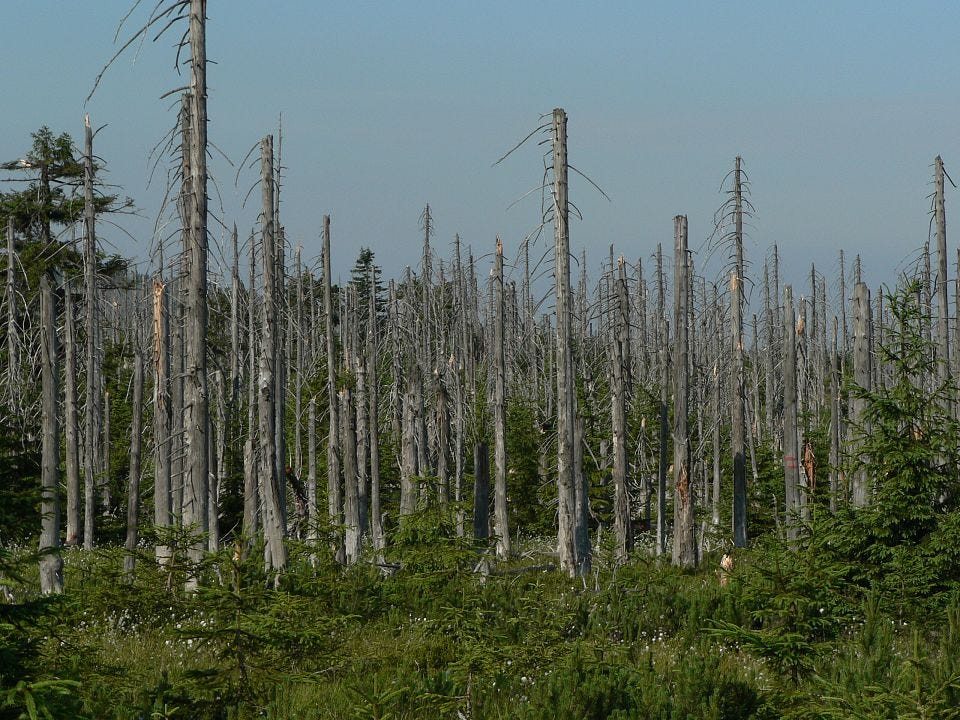
The Silent Attack on Germany's Black Forest
Nearly 2000 years ago, when the Romans invaded Southern Germany, they stumbled upon a forest so dark and murky that they aptly named it Silva Nigra-the Black Forest. Nestled within this forest, lay a small town, which the spa-loving Romans called Aquae, or "waters," for its natural healing waters. Legend has it that Emperor Caracalla, who ruled from 211 to 217 AD, treated his rheumatism in these waters.
As time passed, the town evolved and changed its name to Baden-Baden—literally “bathing-bathing,” to highlight its unique status and to distinguish it from other places named "Baden" that were scattered around Germany and Austria. By the belle époque era (1871–1914), Baden-Baden enjoyed a reputation as Europe's summer spa and cultural capital, a fame that still holds to this day, with the Black Forest continuing to lure tourists from around Europe. But beneath this picturesque and serene setting, the forest hides a darker story—one of environmental disaster.
In the late 1960s, scientists began noticing signs of tree damage in the Black Forest—the once-vibrant foliage of trees was gradually succumbing to an invisible threat. The culprit? Acid rain. Airborne pollutants, like sulphur dioxide (SO2) and nitrogen oxides (NOx) by-products of rapid industrialisation, the ever-growing car culture, and some forms of agriculture, are released into the atmosphere where they reacted with water vapour to form nitric and sulfuric acids. These acids returned to the earth in the form of acid rain, sleet, or snow, poisoning the soil and waterways.
The term ‘acid rain’ was coined in the mid-1800s, by Robert Angus Smith, a Scottish chemist in London. Smith noticed that rain was more acidic in areas with more air pollution and that buildings crumble faster in areas where coal is burned. However, it took another century for scientists to realise that acid rain was a widespread environmental problem.
By the mid-1980s, nearly half of the Black Forest's trees were either dead or dying. What was once a vibrant ecosystem teeming with life, had been reduced to a haunting landscape of blackened, skeletal trees, stark reminders of humanity's impact on nature.
The haunting images of blackened trees in the Black Forest sparked public outrage and became a symbol of the wider environmental crisis. This ecological catastrophe ignited an environmental movement, which led to the emergence of Die Grünen (The Green Party) in 1980. With a platform focused on sustainability, environmental protection, and social justice, the party quickly gained momentum. It soon became a significant force, forever altering Germany's political landscape.
The Poison Knows No Borders
Germany was not the only country to fall victim to acid rain. The Soviet Union (USSR) was home to some of the largest industrial complexes in the world, built without regard for environmental protection or pollution control. Heavy industries, such as metal smelting, chemical production, and energy generation, were widespread, and they emitted large amounts of sulphur dioxide (SO₂) and nitrogen oxides (NOx) into the atmosphere.
Pollutants, unlike humans who are stopped at borders without proper identification, are not as selective. Once unleashed, they roam freely, carried wherever the winds fancy, indifferent to the lines we've drawn on maps. Soviet pollutants were no exception—they didn’t linger politely within the USSR’s boundaries. Rather, they spread to neighbouring nations, with Eastern European countries, particularly Poland, suffering the most.
Poland, heavily dependent on its sulphur-rich coal, known as "Polish black gold," saw its farmlands and forests suffer greatly. Powerless farmers watched their crop yields of potatoes, grain, and other staples dwindle under the corrosive touch of acid rain. At the beginning of the 1980s, the highest pollution was observed in the western Sudets Mountains, especially in a region called “The Black Triangle," encompassing the border area of Poland, the Czech Republic, and Germany. The brown coal power plants in the region have been a major cause of environmental destruction for several decades, emitting high levels of air pollution from intensive coal burning. high levels of air pollution from intensive coal burning.
By the late 1980s, large tracts of mountain forests, once lush and green, were either dead or severely damaged by acid rains. The soil and the lakes in the region showed advanced signs of acidification. . It would take the collapse of the communist regimes and a dramatic shift in industrial practices before any real recovery could begin. But by then, the damage was already etched into the mountains, a grim testament to the environmental recklessness of the era.
How the UK’s Industrial Chimneys Devastated Scandinavia’s Forests
In the mid-20th century, in a classic case of unintended consequences, the UK built tall industrial chimneys, hoping to reduce local air pollution by sending industry pollutants high into the atmosphere. Instead, this "out of sight, out of mind" approach sent sulphur dioxide and nitrogen oxides on a long-distance journey across the North Sea, where they eventually felt as acid rain over Scandinavia. Forests in Norway, Sweden, and Finland suffered severe soil acidification, leading to nutrient depletion and widespread tree damage or death. At the same time, acidification of aquatic ecosystems resulted in numerous rapid biological changes in many lakes and rivers in Scandinavia. Over 90% of Norway's acid pollution in the 1980s was traced to foreign sources, with a significant portion coming from the UK.
But the UK didn’t escape its own environmental consequences. The same acidic compounds that ravaged Scandinavian forests, were eating away at limestone and marble structures in British cities. Statues and monuments, some of which had stood for centuries, began dissolving. The faces of monarchs and proud military men gradually eroded and morphed into unrecognisable blobs. Buildings like St. Paul's Cathedral and Westminster Abbey were hit hard, their stone facades gradually eroding as acid rain dissolved the calcium carbonate in the stone. Britain's historical heritage was washed away by acid rain.
In the early 1980s, acid rain emerged as one of the most severe environmental crises of the era. The issue gained widespread attention as alarming reports about fish extinction in Scandinavian lakes and forest dieback on the European Continent dominated news headlines across Europe.
North America was not spared either. The Appalachian forests in the United States endured extensive damage from acid rain. Similarly, in Scandinavia, emissions from the United States drifted to Canada, devastating boreal forests and contaminating freshwater lakes. The magnitude of the destruction elevated acid rain to a significant political issue in North America, reflecting the worries that had already seized Europe.
Turning the Tide: International Action to Acid Rain Crisis
But as the damage mounted, so too did the global response. Greenpeace activists climbed power plant smokestacks and hung banners in protest. Meanwhile, scientists testified before Congress about the connection between emissions and acid rain, the severity of the effects, and the potential impact of proposed legislation. The power industry, however, questioned the science, warning that regulations would drive electricity rates sky high. Sound familiar? This same pattern of doubt and denial echoes through debates about leaded petrol, chlorofluorocarbons (CFCs), and, more recently, climate change.
Despite the strong resistance, 21 European countries signed the Sulphur Protocol, in Helsinki in 1985. It was a monumental achievement, one of the first legally binding international treaties aimed at reducing cross-border air pollution. (The other one was the Montreal Protocol in 1987, to phase out ozone-depleting substances).
Countries like the UK and Germany, major sulphur emitters, had to make significant changes to meet these targets. They implemented cleaner technologies, shifted away from high-sulphur coal, and installed scrubbers in industrial plants to capture emissions. The impact was almost immediate. Sulphur dioxide (SO2) emissions in Europe have fallen by 84 percent and in the UK, by 98 percent. Forests and lakes across Scandinavia, once devastated by acid rain, began their slow recovery. (Grennfelt & et al), (Hoesly & et al, 2018) In the United States, the Clean Air Act successfully reduced sulphur dioxide emissions and improved environmental and public health. Between 1990 and 2019, emissions in the U.S. dropped by an impressive 93 percent, while nitrogen oxides also saw a steep decline, resulting in significantly less acid deposition across North America.
And the apocalypse of economic doom that the power industry predicted? It never materialised. So, when the power industry in the 1980s argued that controlling acid rain would cripple the economy, it wasn't breaking new ground—it was just recycling the same playbook. In reality, sulphur dioxide regulations did not result in skyrocketing electricity bills. History, it seems, loves to prove naysayers wrong.
Today acid rain has almost disappeared across North America and Europe. Many other countries, like China, are making progress too, even though the country’s coal use more than doubled. What was once seen as an insurmountable crisis has become a remarkable success story, demonstrating that with sufficient political will and investment, even the most daunting environmental challenges can be overcome.
Thank you for reading this Substack. If you think someone else might be interested in this too, please spread the word. If you have any feedback, please comment below.
Bibliography
Acid Rain, Parliamentary Research Papers, 79-37E, Revised, 30 September 1998, Acid rain (79-37E) (publications.gc.ca)
Goldhaber, S. (2021, July 9). Whatever Happened to Acid Rain? Retrieved from American Council on Science and Health : https://www.acsh.org/news/2021/07/09/whatever-happened-acid-rain-15651
Greenpeace, Activities, Success Stories and History a0137_7_ds_gp_chronik_ansicht_en.pdf (greenpeace.de)
Grennfelt, P., & et al. (n.d.). Acid rain and air pollution: 50 years of progress in environmental science and policy. AMBIO, 49, 849-864. doi:https://link.springer.com/article/10.1007/s13280-019-01244-4
Hoesly, R. M., & et al. (2018). Historical (1750–2014) anthropogenic emissions of reactive gases and aerosols from the Community Emissions Data System (CEDS),. Geosci. Model Dev, 11, 369-408. doi:https://doi.org/10.5194/gmd-11-369-2018
Mazurski, K. R. (1986, December 15). The destruction of forests in the polish Sudetes Mountains by industrial emissions. Forest Ecology and Management, 17(4), 303-315. doi:https://doi.org/10.1016/0378-1127(86)90158-1
Pudlis, E. (1983). Poland's Plight: Environment Damaged from Air Pollution and Acid Rain. AMBIO, 12(2), 125-127. Retrieved from https://www.jstor.org/stable/4312889
United States EPA . (n.d.). Retrieved from Acid Rain Program: https://www.epa.gov/acidrain/acid-rain-program
Cassandra Willyard, (April 18, 2010) Acid Rain and Our Ecosystem, Smithonian Magazine, Acid Rain and Our Ecosystem | Smithsonian (smithsonianmag.com)




